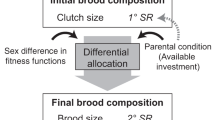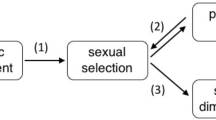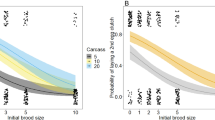Abstract
Two evolutionary theories predict how mammalian parents would be expected to allocate the resources at their disposal to their male and female progeny. Where reproductive success varies more widely among males than females and variation in success among adults is influenced by parental investment1, parents would maximize their reproductive success by allocating a greater proportion of their resources to individual sons than to individual daughters2–5. However, because the benefits of producing offspring of one sex are inversely related to the total investment allocated to them, parents should, on average, divide their total investment equally between their male and female progeny, rearing fewer of whichever sex is individually more expensive to produce6–10. Here we examine the extent to which parental investment in red deer (Cervus elaphus) and other polygynous mammals matches these predictions. We conclude that, in several mammals, mothers invest more heavily in individual sons than daughters but that, contrary to prediction, there is no indication that fewer male offspring are reared in these species.
This is a preview of subscription content, access via your institution
Access options
Subscribe to this journal
Receive 51 print issues and online access
$199.00 per year
only $3.90 per issue
Buy this article
- Purchase on Springer Link
- Instant access to full article PDF
Prices may be subject to local taxes which are calculated during checkout
Similar content being viewed by others
References
Trivers, R. L. in Sexual Selection and the Descent of Man (ed. Campbell, B. G.) 136–179 (Aldine, Chicago, 1972).
Trivers, R. L. & Willard, D. E. Science 179, 90–92 (1973).
Reiter, J., Stinson, N. L. & LeBoeuf, B. J. Behav. Ecol Sociobiol. 3, 337–367 (1978).
Dittos, W.P.J. Behaviour 69, 265–301 (1979).
Maynard Smith, J. Behav. Ecol Sociobiol. 7, 247–257 (1980).
Fisher, R. A. The Genetical Theory of Natural Selection (Oxford University Press, 1930).
MacArthur, R. H. in Theoretical and Mathematical Biology (eds Waterman, T. & Morowitz, H.) 388–397 (Blaidsdell, New York, 1965).
Leigh, E. G. Jr., Am. Nat. 104, 205–210 (1970).
Eshel, I. Heredity 34, 351–361 (1975).
Charnov, E. L. Am. Nat. 113, 465–480 (1979).
Lowe, V. P. W. J. Anim. Ecol. 38, 425–457 (1969).
Glutton-Brock, T.H. & Guinness, F.E. Behaviour 55, 287–300 (1975).
Guinness, F. E., Albon, S. D. & Clutton-Brock, T. H. J. Reprod. Fert. 54, 325–334 (1978).
Clutton-Brock, T. H., Guinness, F. E. & Albon, S. D. Red Deer: The Ecology of Two Sexes. (Chicago University Press, in the press).
Clutton-Brock, T. H., Albon, S. D., Gibson, R. M. & Guinness, F. E. Anim. Behav. 27, 211–225 (1979).
Myers, J. H. Am. Nat. 112, 389–399 (1978).
Williams, G. C. Proc. R. Soc. B205, 567–580 (1979).
Coulson, J. C. & Hickling, G. Nature 190, 281–282 (1961).
Stirling, I. J. Mammal. 52, 842–844 (1971).
Davies, G. Nature 127, 94–95 (1931).
Robinette, W. L., Gashwiler, J. S., Jones, D. A. & Crane, H. S. J. Wildl. Mgmt. 19, 115–136 (1955).
Rivers, J. P. W. & Crawford, M. A. Nature 252, 297–298 (1974).
Teitelbaum, M. S. J. biosoc. Sci. Suppl. 2, 61–71 (1970).
Miller, W. C. Proc. R. phys. Soc. 22, 99–101 (1932).
Verme, L. J. J. Wildl. Mgmt 33, 881–887 (1969).
Mech, L. D. J. Wildl. Mgmt 39, 737–740 (1975).
Andersen, F. S. Oikos 12, 1–16 (1961).
Blaxter, K. L., Kay, R. N. B., Sharman, G. A. M., Cunningham, J. M. M. & Hamilton, W. J. Farming the Red Deer (HMSO, London 1974).
McEwan, E. A. & Whitehead, P. E. Can. J. Zool. 49, 443–447 (1971).
Robbins, C. T. & Moen, A. N. M. J. Wildl. Mgmt 39, 355–360 (1975).
Krebs, C. J. & Cowan, I., Mc, T. Can. J. Zool. 40, 863–869 (1962).
Mitchell, B. & Lincoln, G. A. J. Zool. 171, 141–152 (1973).
Guinness, F. E., Gibson, R. M. & Clutton-Brock, T. H. J. Zool. 185, 105–114 (1978).
Guinness, F. E., Glutton-Brock, T. H. & Albon, S. D. J. Anim. Ecol. 47, 817–832 (1978).
Benedict, F. G. Vital Energetics: A Study of Comparative Basal Metabolism. (Carnegie Institute, Washington, 1938).
Defries, J. C., Touchberry, R. W. & Hayes, R. L. J. Dairy Sci. 42, 598–606 (1959).
Short, R. V. J. Reprod. Fert. 1, 61–70 (1960).
Willis, M. B. & Wilson, A. Anim. Prod. 18, 231–236 (1974).
Glucksman, A. Biol. Rev. 49, 423–475 (1974).
McEwan, E. H. Can. J. Zool. 46, 1023–1029 (1968).
Mitchell, B., Staines, B. V. & Welch, D. Ecology of Red Deer (Institute of Terrestrial Ecology, Cambridge, 1977).
Morrison, F. B. Feeds and Feeding, 21st edn (Morrison, New York, 1948).
Burfening, P. J. Anim. Prod. 15, 61–66 (1972).
Dhillon, J. S., Acharya, R. M., Tiwana, M. S. & Aggarwal, S. C. Anim. Prod. 12, 81–87 (1970).
Singh, O. N., Singh, R. N. & Srivastava, R. R. P. Indian J. vet. Sci. 35, 245–248 (1965).
Simpson, M. J. A., Simpson, A. E., Hooley, J. & Zunz, M. Nature (in the press).
Clutton-Brock, T. H. & Albon, S. D. in Current Problems in Sociobiology (ed. King's College Sociobiology Group) (Cambridge University Press, in the press).
LeBoeuf, J. & Briggs, K. T. Mammalia 41, 167–195 (1977).
Clark, A. B. Science 201, 163–165 (1978).
Author information
Authors and Affiliations
Rights and permissions
About this article
Cite this article
Clutton-Brock, T., Albon, S. & Guinness, F. Parental investment in male and female offspring in polygynous mammals. Nature 289, 487–489 (1981). https://doi.org/10.1038/289487a0
Received:
Accepted:
Issue Date:
DOI: https://doi.org/10.1038/289487a0
This article is cited by
-
Reproductive performance and sex ratio adjustment of the wild boar (Sus scrofa) in South Korea
Scientific Reports (2022)
-
Sex-specific costs of rearing a nestling and its implications in the brood sex ratio of Magellanic penguins
Marine Biology (2021)
-
Maternal effects on offspring growth indicate post-weaning juvenile dependence in chimpanzees (Pan troglodytes verus)
Frontiers in Zoology (2020)
-
Effects of population structure and density on calf sex ratio in red deer (Cervus elaphus)—implications for management
European Journal of Wildlife Research (2018)
-
Individual heterogeneity and offspring sex affect the growth–reproduction trade-off in a mammal with indeterminate growth
Oecologia (2016)
Comments
By submitting a comment you agree to abide by our Terms and Community Guidelines. If you find something abusive or that does not comply with our terms or guidelines please flag it as inappropriate.



